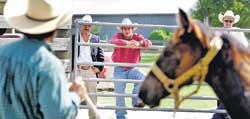
Master ranchersA university degree for cowboys prepares managers for a complex business KINGSVILLE, Texas (AP) - Once upon a time, in the Wild West, all it took to raise cattle was land, grass and cowboys who knew how to rope the critters. Now, it may take an MBA. Texas A&M University-Kingsville's Institute for Ranch Management is offering what university officials call the first ever masters degree program for ranchers - sort of a Harvard Business School for cowboys. In addition to graduate-level business courses, students are schooled in rangeland specialties, including animal nutrition and wildlife management.
During a Friday noon session over brown bag lunches, a laptop computer beams a long list of letters and numbers. It's an equation, Les Nunn tells his colleagues in cowboy hats, for getting the most beef out of your pastures' grass. Nunn's Power Point presentation, "Searching for the Economic Optimum Stocking Ratio," follows another student's profit loss analysis of a government incentive program for land conservation and another's stab at formulas for sharing land between hunting lessees and livestock. It's an exclusive club, coming with the promise of a job after graduation. The first graduating class had two students; the current class has four, with seven students enrolled in the program this year. Twenty students applied for a slot. The program signals a new era for the occupation. In the past, those aspiring to careers in ranch management might have pursued degrees in animal science or agriculture and rounded out their resumes with on the job training. Today's ranchers also need business and wildlife management skills."You can't just be an animal nutritionist and horse person and manage a ranch any more," said Barry Dunn, PhD, a former South Dakota rancher who heads the program. "The market for most of ranching's history has been a commodities market," he said. "But now the markets are moving into specialized (fields) - whether its hunting or specialized beef production, like Nolan Ryan beef. All of that just adds more and more sophistication." The King Ranch, which endowed the institute and allows students to do fieldwork on its grounds, epitomizes the kind of modern ranch the school wants its students to be able to manage. At 825,000 acres (334,000 hectares), it is the largest ranch in the United States, so vast it appears as a dark spot from outer space, so unspoiled it has more species of birds than the Florida Everglades. It includes a small school district for its employees' children. It originated several cattle strains and is considered the birthplace of American ranching. But these days, cattle raising is only a small part of the ranch's operations, which include oil and gas leases, ecotourism, hunting tours, a publishing company and a retail arm. The ranch also farms cotton and citrus. Its corporate headquarters are in Houston, 200 miles (320 kilometres) away. David Delaney, vice president and general manager of ranching operations, said he spends at least 60 percent of his time in front of a computer, managing all the operations with charts and spreadsheets. Much of the other time he's out hobnobbing, "being the face of the King Ranch." Yet he still knows each of the ranch's 160 pastures, and a stop with students to view grazing heifers turns into an impromptu lecture about the merits of various feed grass. "I would have gone to this program if it had been available at the time," said Delaney, who grew up in Virginia and started out wanting to be a vet. "But there was no such thing." Students already have helped the ranch by using computer modeling to show which deer to develop to attract hunters, determining how many heifers to expose to each bull to maximize breeding, and developing an electronic identification system for animals in advance of the federal National Cattle Identification System, which is due to start in 2009 to track diseases. The institute opened with two students in 2004, who graduated in 2006. Dunn said plans are to keep each class at four students, who enroll as fellows and receive free tuition, university health benefits, and a modest living stipend for the two-year program. Summers are spent doing internships at ranches across the country. The class size is kept small to ensure the institute remains elite and is able to place its graduates in jobs, Dunn said.
While students will be equipped to manage megaranches like the King Ranch, Dunn said they will also have the blend of skills needed to manage federal parks or wildlife refuges.
Current students range in age from 29 to 43 and come from Texas, Oregon, South Dakota, Florida, Arizona, Nevada, and New Mexico. |
|| Front
Page | News | Editorial | Columns | Sports | Plus | Financial
Times | International | Mirror | TV
Times | Funday
Times || |
| |
Reproduction of articles permitted when used without any alterations to contents and the source. |
© Copyright
2007 Wijeya
Newspapers Ltd.Colombo. Sri Lanka. All Rights Reserved. |
